VAUXHALL ANTARA 2015 Owner's Guide
Manufacturer: VAUXHALL, Model Year: 2015, Model line: ANTARA, Model: VAUXHALL ANTARA 2015Pages: 223, PDF Size: 6.07 MB
Page 31 of 223
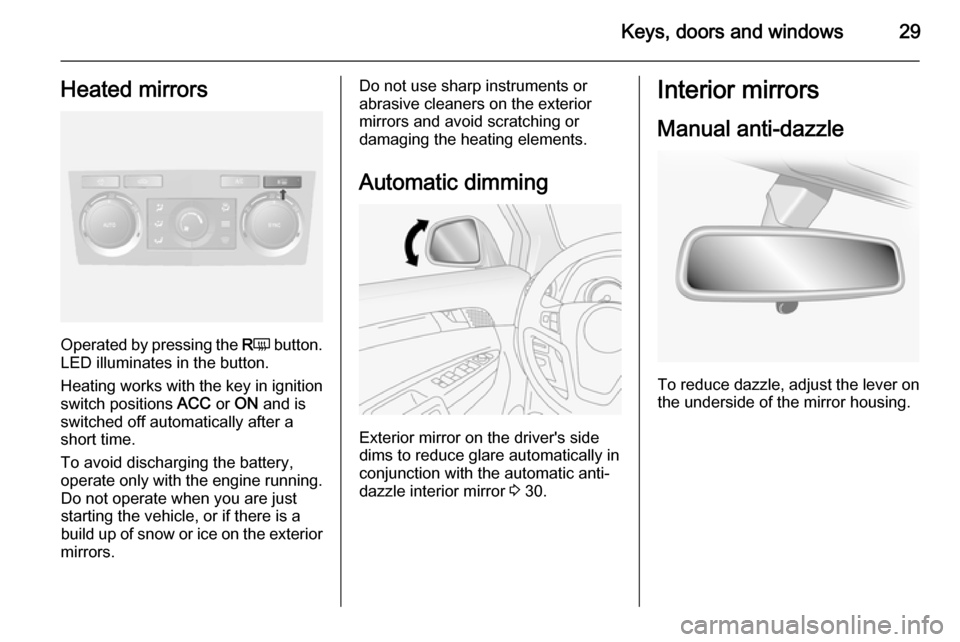
Keys, doors and windows29Heated mirrors
Operated by pressing the RÜ button.
LED illuminates in the button.
Heating works with the key in ignition
switch positions ACC or ON and is
switched off automatically after a
short time.
To avoid discharging the battery, operate only with the engine running. Do not operate when you are juststarting the vehicle, or if there is a
build up of snow or ice on the exterior
mirrors.
Do not use sharp instruments or
abrasive cleaners on the exterior
mirrors and avoid scratching or
damaging the heating elements.
Automatic dimming
Exterior mirror on the driver's side
dims to reduce glare automatically in
conjunction with the automatic anti-
dazzle interior mirror 3 30.
Interior mirrors
Manual anti-dazzle
To reduce dazzle, adjust the lever on the underside of the mirror housing.
Page 32 of 223
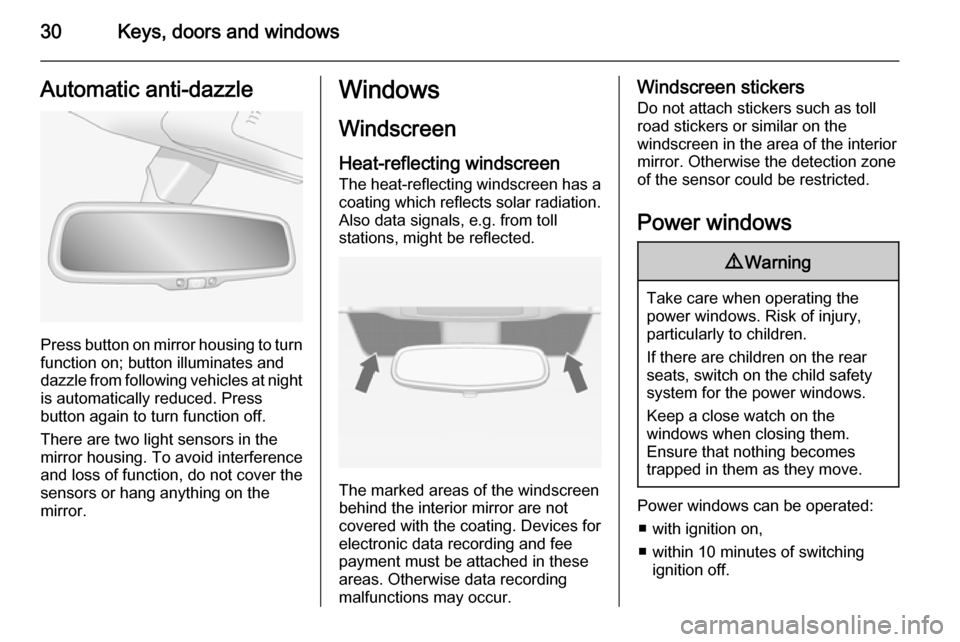
30Keys, doors and windowsAutomatic anti-dazzle
Press button on mirror housing to turn
function on; button illuminates and
dazzle from following vehicles at night
is automatically reduced. Press
button again to turn function off.
There are two light sensors in the
mirror housing. To avoid interference
and loss of function, do not cover the
sensors or hang anything on the mirror.
Windows
Windscreen
Heat-reflecting windscreen The heat-reflecting windscreen has a
coating which reflects solar radiation.
Also data signals, e.g. from toll
stations, might be reflected.
The marked areas of the windscreen
behind the interior mirror are not
covered with the coating. Devices for
electronic data recording and fee
payment must be attached in these
areas. Otherwise data recording
malfunctions may occur.
Windscreen stickers
Do not attach stickers such as toll
road stickers or similar on the
windscreen in the area of the interior
mirror. Otherwise the detection zone
of the sensor could be restricted.
Power windows9 Warning
Take care when operating the
power windows. Risk of injury,
particularly to children.
If there are children on the rear seats, switch on the child safety
system for the power windows.
Keep a close watch on the
windows when closing them.
Ensure that nothing becomes
trapped in them as they move.
Power windows can be operated:
■ with ignition on,
■ within 10 minutes of switching ignition off.
Page 33 of 223
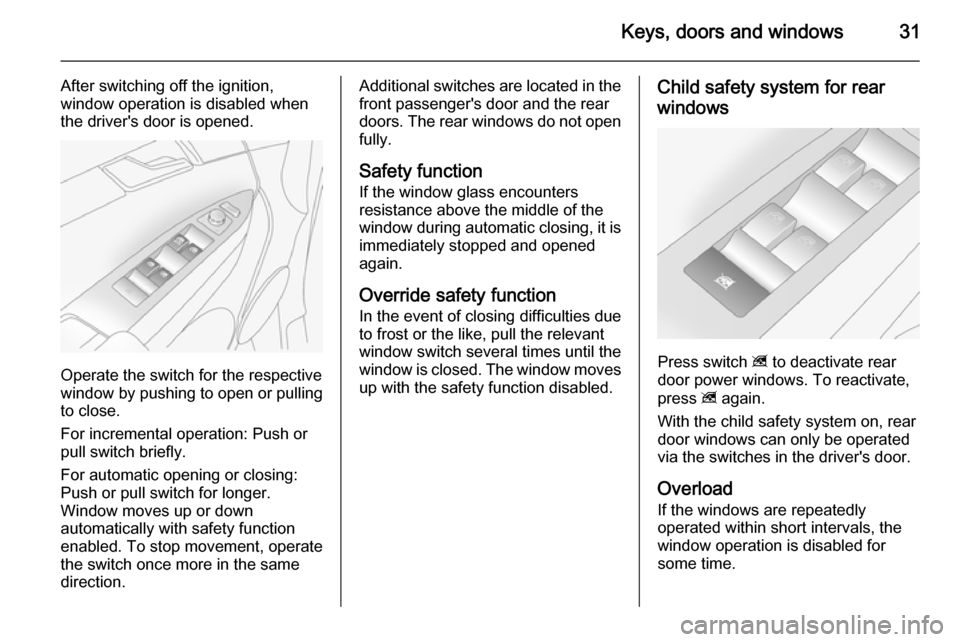
Keys, doors and windows31
After switching off the ignition,
window operation is disabled when the driver's door is opened.
Operate the switch for the respective
window by pushing to open or pulling to close.
For incremental operation: Push or
pull switch briefly.
For automatic opening or closing:
Push or pull switch for longer.
Window moves up or down
automatically with safety function
enabled. To stop movement, operate
the switch once more in the same
direction.
Additional switches are located in the
front passenger's door and the rear
doors. The rear windows do not open fully.
Safety function
If the window glass encounters
resistance above the middle of the
window during automatic closing, it is
immediately stopped and opened
again.
Override safety function In the event of closing difficulties due
to frost or the like, pull the relevant
window switch several times until the
window is closed. The window moves
up with the safety function disabled.Child safety system for rear
windows
Press switch z to deactivate rear
door power windows. To reactivate,
press z again.
With the child safety system on, rear
door windows can only be operated
via the switches in the driver's door.
Overload If the windows are repeatedly
operated within short intervals, the
window operation is disabled for
some time.
Page 34 of 223
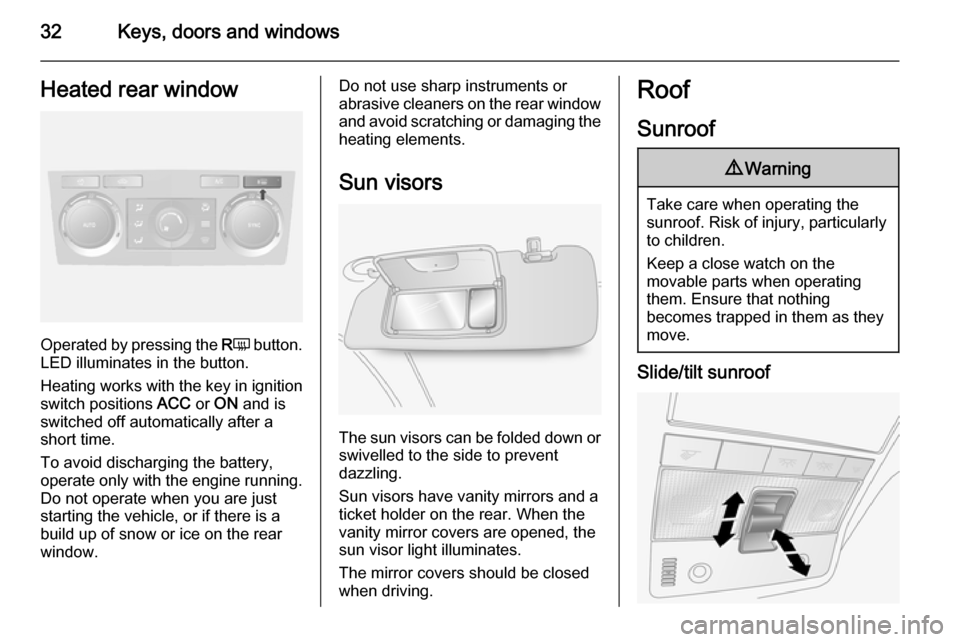
32Keys, doors and windowsHeated rear window
Operated by pressing the RÜ button.
LED illuminates in the button.
Heating works with the key in ignition
switch positions ACC or ON and is
switched off automatically after a
short time.
To avoid discharging the battery, operate only with the engine running. Do not operate when you are juststarting the vehicle, or if there is a
build up of snow or ice on the rear
window.
Do not use sharp instruments or abrasive cleaners on the rear window
and avoid scratching or damaging the
heating elements.
Sun visors
The sun visors can be folded down or swivelled to the side to prevent
dazzling.
Sun visors have vanity mirrors and a
ticket holder on the rear. When the
vanity mirror covers are opened, the
sun visor light illuminates.
The mirror covers should be closed
when driving.
Roof
Sunroof9 Warning
Take care when operating the
sunroof. Risk of injury, particularly to children.
Keep a close watch on the
movable parts when operating
them. Ensure that nothing
becomes trapped in them as they
move.
Slide/tilt sunroof
Page 35 of 223

Keys, doors and windows33
For incremental operation, brieflypress the switch in the required
direction. For automatic opening or
closing, press and hold the switch.
Open
Press switch rearwards; it will open
automatically unless the switch is
pressed again in another direction, or
released.
Notice
If the top of the roof is wet, tilt
sunroof, allow water to run off and
then open sunroof.
Close
Press and hold switch forwards.
Release switch when sunroof
reaches desired position.
Tilt
Press and hold switch upwards.
Release switch when sunroof
reaches desired position.
To return sunroof to its original
position, pull and hold switch
downwards. Release switch when
sunroof reaches desired position.General hints
Function standby
The sunroof can be operated:
■ with ignition on,
■ within 10 minutes of switching ignition off,
After switching off the ignition,
sunroof operation is disabled when
driver's door is opened.
Page 36 of 223
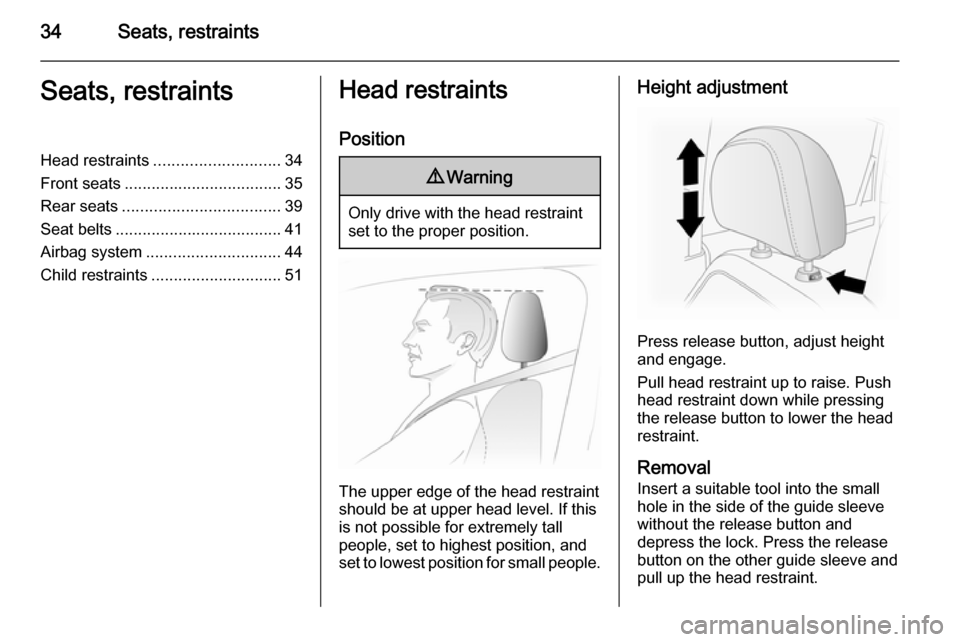
34Seats, restraintsSeats, restraintsHead restraints............................ 34
Front seats ................................... 35
Rear seats ................................... 39
Seat belts ..................................... 41
Airbag system .............................. 44
Child restraints ............................. 51Head restraints
Position9 Warning
Only drive with the head restraint
set to the proper position.
The upper edge of the head restraint
should be at upper head level. If this
is not possible for extremely tall
people, set to highest position, and
set to lowest position for small people.
Height adjustment
Press release button, adjust height
and engage.
Pull head restraint up to raise. Push
head restraint down while pressing
the release button to lower the head
restraint.
Removal
Insert a suitable tool into the small
hole in the side of the guide sleeve
without the release button and
depress the lock. Press the release
button on the other guide sleeve and
pull up the head restraint.
Page 37 of 223
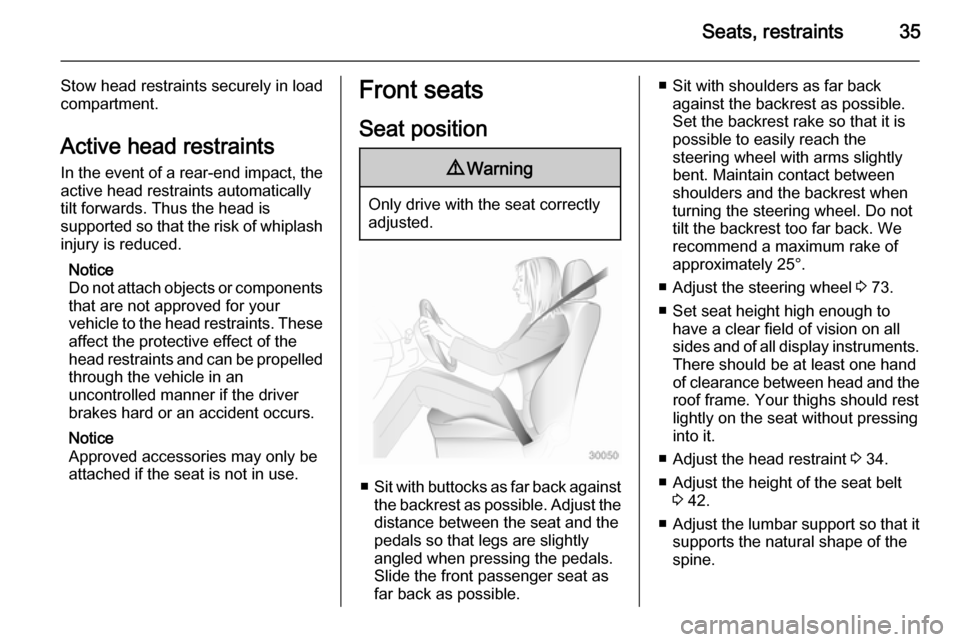
Seats, restraints35
Stow head restraints securely in load
compartment.
Active head restraints
In the event of a rear-end impact, the active head restraints automatically
tilt forwards. Thus the head is
supported so that the risk of whiplash
injury is reduced.
Notice
Do not attach objects or components
that are not approved for your
vehicle to the head restraints. These affect the protective effect of the
head restraints and can be propelled
through the vehicle in an
uncontrolled manner if the driver
brakes hard or an accident occurs.
Notice
Approved accessories may only be
attached if the seat is not in use.Front seats
Seat position9 Warning
Only drive with the seat correctly
adjusted.
■ Sit with buttocks as far back against
the backrest as possible. Adjust the distance between the seat and the
pedals so that legs are slightly
angled when pressing the pedals.
Slide the front passenger seat as
far back as possible.
■ Sit with shoulders as far back against the backrest as possible.
Set the backrest rake so that it is possible to easily reach the
steering wheel with arms slightly bent. Maintain contact between
shoulders and the backrest when
turning the steering wheel. Do not
tilt the backrest too far back. We
recommend a maximum rake of
approximately 25°.
■ Adjust the steering wheel 3 73.
■ Set seat height high enough to have a clear field of vision on allsides and of all display instruments. There should be at least one hand
of clearance between head and the
roof frame. Your thighs should rest
lightly on the seat without pressing
into it.
■ Adjust the head restraint 3 34.
■ Adjust the height of the seat belt 3 42.
■ Adjust the lumbar support so that it
supports the natural shape of the
spine.
Page 38 of 223
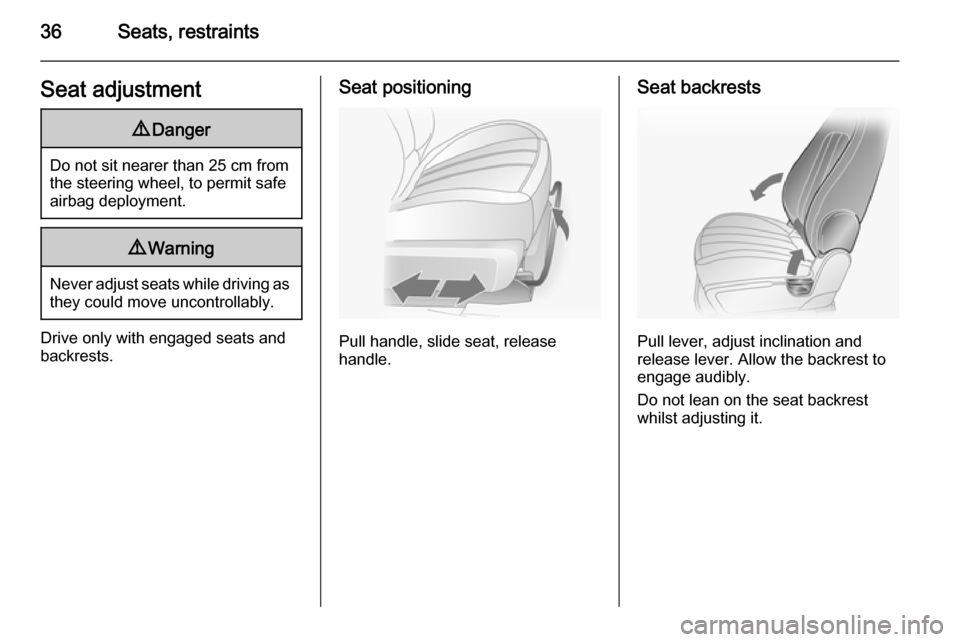
36Seats, restraintsSeat adjustment9Danger
Do not sit nearer than 25 cm from
the steering wheel, to permit safe
airbag deployment.
9 Warning
Never adjust seats while driving as
they could move uncontrollably.
Drive only with engaged seats and
backrests.
Seat positioning
Pull handle, slide seat, release
handle.
Seat backrests
Pull lever, adjust inclination and
release lever. Allow the backrest to
engage audibly.
Do not lean on the seat backrest
whilst adjusting it.
Page 39 of 223
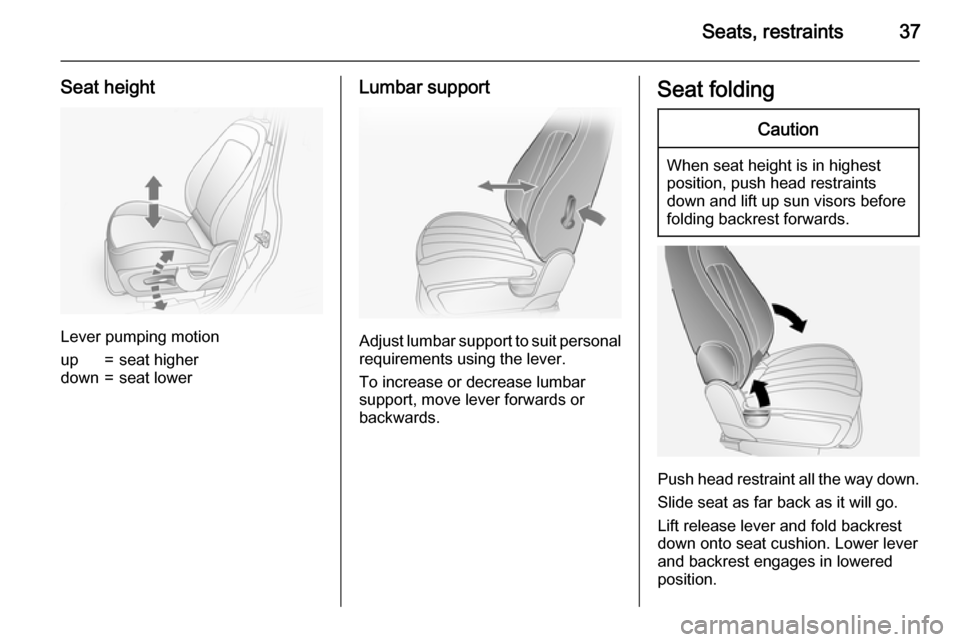
Seats, restraints37
Seat height
Lever pumping motion
up=seat higherdown=seat lowerLumbar support
Adjust lumbar support to suit personalrequirements using the lever.
To increase or decrease lumbar
support, move lever forwards or
backwards.
Seat foldingCaution
When seat height is in highest
position, push head restraints
down and lift up sun visors before
folding backrest forwards.
Push head restraint all the way down.
Slide seat as far back as it will go.
Lift release lever and fold backrest
down onto seat cushion. Lower lever
and backrest engages in lowered
position.
Page 40 of 223
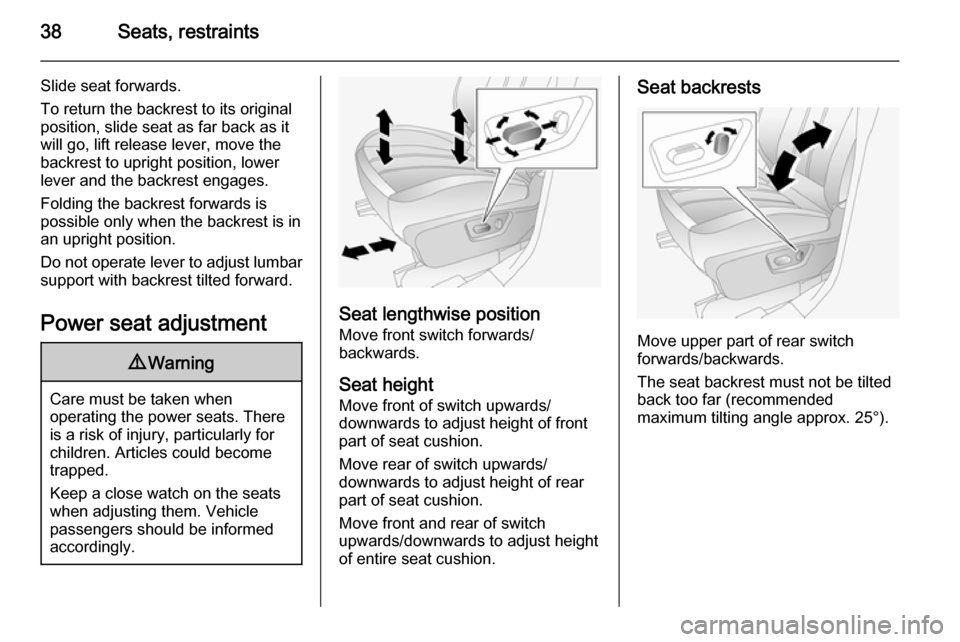
38Seats, restraints
Slide seat forwards.
To return the backrest to its original
position, slide seat as far back as it
will go, lift release lever, move the
backrest to upright position, lower
lever and the backrest engages.
Folding the backrest forwards is
possible only when the backrest is in
an upright position.
Do not operate lever to adjust lumbar support with backrest tilted forward.
Power seat adjustment9 Warning
Care must be taken when
operating the power seats. There
is a risk of injury, particularly for
children. Articles could become
trapped.
Keep a close watch on the seats
when adjusting them. Vehicle
passengers should be informed
accordingly.
Seat lengthwise position
Move front switch forwards/
backwards.
Seat height
Move front of switch upwards/
downwards to adjust height of front
part of seat cushion.
Move rear of switch upwards/
downwards to adjust height of rear
part of seat cushion.
Move front and rear of switch
upwards/downwards to adjust height
of entire seat cushion.
Seat backrests
Move upper part of rear switch
forwards/backwards.
The seat backrest must not be tilted
back too far (recommended
maximum tilting angle approx. 25°).